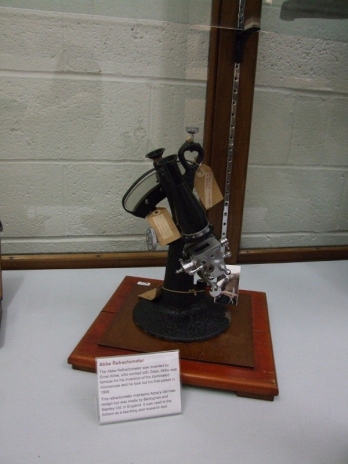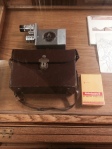
The presence of our museum project on campus has recently increased, with the installation of a new display in the School of Earth and Environment. The display, Earth Education at Leeds: The Whole World in a Ray of Light, is the result of work Jessica Henderson and Laura Sellers started back in January this year, and is finally available for viewing by students, staff and visitors of the University of Leeds.
On investigating the storage rooms within the School, roughly 100 items were found, including instruments that played an important role in the history of earth sciences, but have now been superseded by new technology and become comparatively rare. As this collection was undocumented, Jessica and Laura began the time-consuming and at times bewildering task of trying to identify these objects, in order to create a catalogue of them. The completed catalogue can be accessed by museum members via Google documents.
From this collection Jessica and Laura chose objects to include in their display, which is grouped into three broad themes. It begins with instruments used to aid human senses when making observations in environmental surveying. For example, telescopic alidades like the one below were used to view and trace the line of sight to distant objects on a plan table. The surveyor can then measure the angle from this object to a reference point at a known distance. From this they can calculate the distance to their object of interest, making this instrument useful in the creation of precise maps. The alidade below, with its case allowing for easy transportation, was manufactured by Wild Heerbruug of Switzerland, and bought by the University of Leeds’ Research Institute of African Geology.

 The second shelf features instruments used when the human eye needs slightly more help to make observations at a greater level of detail is required. Focussing on microscopes, the stand-out object in this section is perhaps this very early example of a microscope stage, c.1900, which allows a mirror to be positioned so it will reflect like through a sample.
The second shelf features instruments used when the human eye needs slightly more help to make observations at a greater level of detail is required. Focussing on microscopes, the stand-out object in this section is perhaps this very early example of a microscope stage, c.1900, which allows a mirror to be positioned so it will reflect like through a sample.
The display then progresses on to instruments used to discover the most fundamental features of samples, such as their chemical composition. For example, this refractometer, based on the design  of Ernst Abbe but manufactured by Bellingham and Stanley Ltd. in England, was used to take precisely measure refractive indexes. These values tell the scientist about the way light or other types of radiation propagate through the material being investigated.
of Ernst Abbe but manufactured by Bellingham and Stanley Ltd. in England, was used to take precisely measure refractive indexes. These values tell the scientist about the way light or other types of radiation propagate through the material being investigated.
This project was funded by a grant from the British Society for the History of Science (BSHS). The money was used to restore the display case and purchase supplies. Keep an eye on the museum webpage for more information on the collection coming soon. In the meantime, please all go and take a look at the display. Ask for directions to it at the School reception.
 The Leeds based arts group Pavilion hosted an event entitled “From the Field to the Museum: Concepts of time in the artistic practices of Mark Dion” in the Brotherton Library on the 1st May 2014. The lecture is part of a longer series exploring “the geological”. The talk by Bergit Arends addressed works by artist and sculpture Mark Dion, “with attention to fieldwork and re-enactment, set in relation to concepts of time and the Anthropocene” as part of a discussion on nature and culture.
The Leeds based arts group Pavilion hosted an event entitled “From the Field to the Museum: Concepts of time in the artistic practices of Mark Dion” in the Brotherton Library on the 1st May 2014. The lecture is part of a longer series exploring “the geological”. The talk by Bergit Arends addressed works by artist and sculpture Mark Dion, “with attention to fieldwork and re-enactment, set in relation to concepts of time and the Anthropocene” as part of a discussion on nature and culture.





